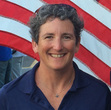Carol Newman Cronin's Blog, page 63
July 18, 2011
Ebook Cover Design: Telling the Story
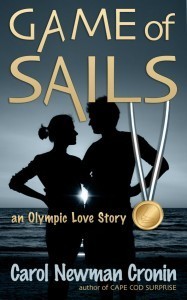
The new cover fits in better as a contemporary romance.
One of the many distinctions between ebooks and paper books is what you see first when you pick up the book to start reading again. With a paperback or hardcover, you see the cover, every time. With an ebook, you're automatically sent to the page on which you ended your last reading session. Pushed back into the story, rather than having to page your way from cover to bookmark.
That may reduce the familiarity caused by repeated sightings, but it doesn't make the ebook cover less important. Ebooks need distinctive covers just as badly as their paper cousins.
Scroll down through any list of ebooks and a few covers catch your eye, standing out from the crowd—just like browsing the shelves in a brick and mortar store. Cover design tells the reader intuitively what to expect from a book, which is why traditional publishers have entire departments devoted to cover creation. Much more than the word choice on page 126, it's crucial for sales to get it right.
I didn't get it right the first time with Game of Sails. The original cover was designed mostly out of laziness; I knew I didn't have a photo that would be generic enough, so I started from a blank light blue background. The result, in the words of Paula Margulies, looked "like child's artwork." She (and all but one of the others who gave me feedback) didn't see the five sails as intended: representations of the five Olympic rings. Instead, all Paula saw was something that would tell people they were opening another young adult book.
"You've got to sell the romance," she said. "You need two people on the cover, not colored sails."
So after heaving several large sighs and thinking how long it would take, I began a search through iStockPhoto. I wasn't sure I'd ever find something that would work. After all, I was looking for a photo of two people I knew well—but who didn't exist anywhere beyond the page. And they had to look like they were attracted to each other but fighting it—and it had to be outside. But not outside in a field, or a yard, or a parking lot. Outside on the water…
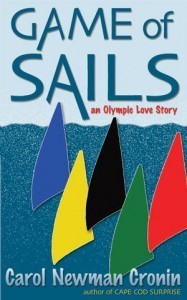
The original cover, which shows five sails as Olympic rings... at least to me.
What were the odds of finding something so specific?
As it turned out, it was just a question of finding the right keywords for my search. After trying "man+woman+yearning" led me to chains and more than few whips, I changed "yearning" to "relationship." Closer, but still lots of bedrooms and smoky restaurants. So I tried adding "watersports" and came up with nothing.
Then I tried "relationship+outside," and somewhere on page 6 I hit the jackpot. No, Casey doesn't have a thick braid and yes, she's a bit too short. But the atmosphere created by the photo was just right. I hit download.
The rest was one of my favorite design challenges: overlaying text so it would be legible, highlight the photo, and balance the page. I added the medal to make it clear what was at stake.
Of course updating the cover isn't something you can do with a paper book. But with ebooks, I simply uploaded the file and —bingo! Within 24 hours the personality change was made.
What do you think? Does the new cover do a better job of conveying "Olympic love story" than the old one? Let me know in the comments below, and I'll send a random commenter a coupon for a free download.
July 6, 2011
Game of Sails Ebook Now Available
Today I'm raising a glass to the launch of my first adult novel, Game of Sails. Straight up, with an e-twist! And to celebrate I'm offering a few lucky blog readers a coupon for a free download.
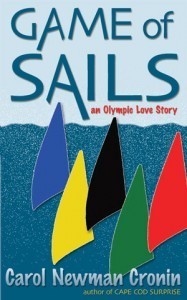
Game of Sails, an Olympic love story, is now available as an eBook.
Recently, traditional publishing has been turned on its ear by the digital age. Agents offer publishing services; publishers negotiate directly with authors; authors market directly to readers; readers buy books from authors they've never heard of. Next thing we know, dogs will be sleeping with cats.
And out of all this chaos, one shining truth remains: everyone is still looking for a great story. Since authors are the creators, we have more power than we think.
I started writing "A Game of Sails" way back in 1994, long before I dreamed of going to the Olympics. Trying to fulfill my childhood dream of becoming a published author (and following the age-old advice to "write what you know"), I started a novel about competitive sailing. As part of my research, I helped on the race committee for the 1996 Olympic Trials—never dreaming I would win the next Trials event I attended. Sometimes truth is stranger than fiction.
I also made my first attempt to find an agent, long before the manuscript was ready to leave my desk. Fortunately I got some great advice from Emilie Jacobsen at Curtis Brown, who'd been my grandmother's agent. She encouraged me to keep writing, while gently pointing out the many, many gaping holes in my story.
In 2000 I decided to put together my own Olympic campaign, which meant a four year writing hiatus. And after I came back from the 2004 Games, I was greeted by this almost-done manuscript about two opposites who team up to qualify for the Olympics. Could it be that I'd finally completed the necessary research to finish the damned thing?
I began to write again, filling in the blanks and adding details sparked by my memories. I also started Agent Search #2. Response was better, but still I was told it was a niche book that would never appeal to mainstream readers.
Meanwhile, I wrote a Christmas story for my nephew that did appeal to a publisher, and that's how Oliver's Surprise came into the world. While I wound my way through the excitement of book layouts, publishing, and signing events, Game of Sails sat by quietly, almost forgotten.
And then the publisher suggested a sequel, and last year Cape Cod Surprise made its debut. Another round of edits, proofing, signings, press releases. I had already learned that books didn't sell themselves, but I was also enjoying the process. Especially the readers who talked about Oliver's world like it really existed.
Finally, in the fall of 2010, I decided to use my new-found writing and marketing knowledge to finish and market Game of Sails. I spent the winter editing, revising, tossing out the stuff that got in the way of the story. And by spring I was ready for Agent Search #3.
I queried, edited, queried again. And while I waited for a response, I became more and more intrigued with the ebook option.
In the past year or two, a revolution has taken place. Authors are publishing their own books directly through sites like Smashwords, Kindle Direct, and Barnes and Noble's PubIt. And the ones with a great story and some marketing savvy are reporting good sales.
Agents and publishers have noticed. And while some have reacted with panic, others have embraced the ability for authors to control their own publishing destiny. Just hours after I made the decision to publish Game of Sails as an eBook, Nathan Bransford's "This Week in Books" blog landed in my inbox. I quickly followed the link to Rachel Gardner's blog post which declared, among other things, that "Self-publishing probably will not hurt your chances of traditional publishing." She goes on to admit that this is "a 180 degree switch from just a few years ago."
Gut instincts confirmed by a pro—gotta love it. I dug into the free Smashwords Style Guide and several tweaks later had published Game of Sails. Available to all, around the world, formatted for all the different e-readers including Kindle, Nook, and iPad.
Best of all, only a few hours later I was notified of my first two sales—before I'd even sent word to any relatives or friends!
I'll keep you updated on the book's progress out into the world. In the meantime, to reward my devoted blog readers, I will send a coupon for a free download to the first ten people to comment on this blog.
And so today I celebrate another launch day, one year after Cape Cod Surprise's lovely party. Less fanfare, for sure. But it's just a modern e-twist on a great story.
June 17, 2011
Paperbacks or Protons: It's Still All About the Story
Twenty-six years ago I made the colossal leap from typewriter to computer, a transition so liberating it is quite simply impossible to imagine ever going back. Suddenly my fingers could keep up with my imagination and typos could be dealt with after the story was captured! Look ma, no whiteout.
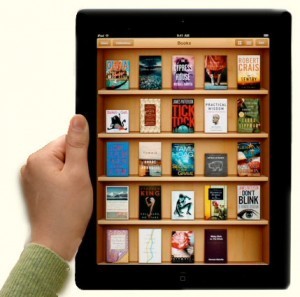
The iPad2's iBookstore does the best job of simulating a "real" library.
And now I face another colossal leap. The ebook revolution offers a dizzying array of options for both authors and readers. Any author with an original story to share can go online, follow a few simple instructions, and in the time it takes to replace the word "paper" with "proton," produce an ebook that can be accessed directly by a reader.
But is publishing an ebook really the same no-brainer step forward for my career as an author that word processing was for my writing?
No one really knows where the ebook revolution will lead. But it's already had a radical effect on expectations, contracts, and the perception of self-publishing. Authors can now market directly, reaching out through our own websites as well as a variety of epub sites like Smashwords, Kindle, and PubIt. And readers have access to a much wider variety of stories—not just those in the same genre as the latest bestseller.
What's not changing is the need for a great story. And a great story only surfaces after all the unnecessary words have been chipped away, which means that great editors are still needed too.
As more and more well-edited books appear in protons rather than on paper, the reputation of self-published ebooks will improve. After all, the reason self-publishing got such a bad name in the first place was the lack of quality control. Authors who give their work the same scrutiny a regular publisher would (or more) will quickly attract and maintain a wide audience.
I've heard from several authors that they're selling more ebooks than they ever expected. Best of all, they've got much more control of their product than they would with a traditional publisher, and they keep a large percentage of the sales price. So what's not to like about ebooks?
Here's the downside. Protons can't be "owned" in the same way a paper book sitting on a shelf can be, and they can't be passed off to a friend. And as an author, holding an ereader in my hands that contains my book will never replace the tactile joy of holding the "real" paper copy.
So as both author and reader, I'll embrace the ebook revolution—but I'm not ready to give up on paper without a backward glance, the way I gave up the typewriter a quarter century ago. If I really want to own or loan a book I care about, I'll buy the paper copy. Because you can't own protons; they belong to the world.
May 23, 2011
From Australia to Chicago and Miami to Rhode Island: A Week of Variety in Books and Boats
I spent yesterday on the couch reading "Dreamlines, A Story of Australia" by Barbara Wood. Instantly transported to nineteenth century Melbourne, I basked in the dry heat while swatting at imaginary flies. It was the perfect accompaniment to a rather dreary Sunday, with an easy to follow story and character arcs.

A placid barefoot day drifting south with the ebb toward the Jamestown Bridge—what could be better?
Last week I read Elizabeth Berg's "Dream When You're Feeling Blue," also fiction and also full of engaging characters. But 1940's Chicago made me shiver, not sweat. And Berg's characters asked tougher questions about war, women's rights, sacrifice, and the strength of family ties. I couldn't have possibly plowed through this book in one day; it needed several nights of digestive thought.
And that's what I love about reading: we can choose our preferred climate, century, and depth of engagement. If we hit it right (as I did yesterday), stories enrich our solitude and take us outside our own lives. If we hit it wrong—well, we can always pick up something else. That's why books on the nightstand are as valuable as money in the bank.
Two weeks ago I raced Snipes with a skipper who quietly stated that he wanted to rip out the heart of every other competitor on the race course. Of course on shore he loaned tools, boats, and brute strength even before he was asked, offering that unique mix of cooperative competitiveness I so love about small boat racing. Wanting to win should encourage us to help our competitors improve; the better they are, the more they challenge us to sail our best.
Five days later, I found myself alone in the middle of Narragansett Bay, drifting south with the ebb tide. I spent the leisurely cruise consciously savoring the first-sail-of-the-season, the gleaming varnish, the early shimmer of seabreeze—and the rare sunshine. I felt lucky to be on the water, and quite content—even with a complete absence of competition.
In less than a week, I traveled from one end of the competitive spectrum to the other—all without setting foot in a boat with an engine. No matter what my psyche demands—solitude, heart-ripping competition, or something in between—I can find it on the water.
So here's another place where books meet boats—they each provide a seemingly endless variety of experience. I can escape for a day or a week, to a harbor down under or a heartland city. Best of all, I can travel light—my imagination will be all the baggage I need.
May 5, 2011
When Words Meet Widgets

A graphic outline helps me plot, but it can't convey the depth of words on the page.
Sharp-eyed readers of this blog will notice a new WordPress template in use here. The endless search for a new look (download—preview—repeat) started me thinking once again about format; if content is king, why is it so important to find that perfect layout, font, background color, and header?
Apparently there's a scientific explanation; the human brain responds far more powerfully to images than text. That's why we judge books by their covers, and why word counts are shrinking to make room for larger photos. Content may be king, but unless it is pleasing to the eye and easy to follow, busy readers will move on to the next blog.
So why expend all this energy on WRITING, for goodness sake? Why do oral and written communication still dominate, when we could turn our ideas into a fun Photoshop graphic instead?
Fortunately for writers, text is what gives a story depth. A picture may be worth a thousand words, but without a caption a photo can be interpreted a thousand different ways. Words are the building blocks of our ideas.
Best of all is when images and words work together, easing entry into a story and then rewarding those who stick around to the end. That's what I've always tried to convey to my clients: the artful integration of images and text is the strongest messenger of all. There's a reason why newspapers, newsletters, and most websites are laid out in a careful balance of graphics and words. The combination soothes our conflicting impulses to understand the story immediately AND to gain a deeper understanding of the issue, product, event, or conflict.
Most authors rely exclusively on words to hook readers; we can't fall back on images to blast open the door to our world. The first sentence, first paragraph, and first chapter will either hook a reader or send her scurrying off to pick up the next enticing cover.
But once hooked, there is nothing more magical and wondrous. Our image-oriented brains take that black and white text and instantly translate it into a picture on the biggest screen of all—the one between our ears.
I may not understand the science, but I sure get the joy.
Thanks for following. Hopefully you like the new format, and please share your favorite example of graphic/text integration.
April 15, 2011
Stirring Stories from the Mental Melting Pot
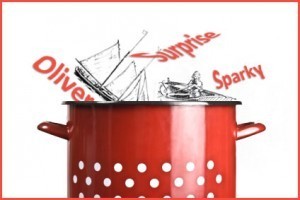 This post first appeared on Write on the Water, a blog site for all of you who "want to quit your job, move onto a boat, and write."
This post first appeared on Write on the Water, a blog site for all of you who "want to quit your job, move onto a boat, and write."
Last week I answered questions from a very bright third grade class. They asked about editing ("Do your stories change after you write them?"), and I told them that second drafts are where the real story appears. They asked about my sailing ("Did you just watch the Olympics, or did you actually play?"), so I tried to explain what an honor it was to represent my country.
Finally, they got around to the big one: "Where do you get your ideas?"
After countless booksignings and author interviews, I should be used to this question—but I have yet to develop a satisfying answer. I usually fall back on the stock reply: "my imagination." Since that's not really an explanation, here's an example.
I came up with the idea for Oliver's Surprise while gazing out the window on an October morning, trying to write a Christmas story for my 12 year old nephew. I stare out the window all the time, and usually I don't actually see what's right in front of me. But on this particular day, my eye was caught by a nondescript leaf blowing down the street toward Narragansett Bay.
At the end of our street is a small boat yard, which that year was struggling to redefine itself under a new owner. And moored off the boatyard was our 1938 Herreshoff Marlin, which would soon be hauled out for the winter.
As my eyes followed the leaf, I found myself wondering: what would happen if a 12 year old boy like my nephew decided to play hooky on a September afternoon, and he followed the leaf down the street to the boat yard…
And then my thoughts danced off in a practical direction: finding a yard qualified to haul an old wooden boat that survived the '38 Hurricane…
…until I dragged my mind back to the problem at hand: what would this boy find at the end of the street that was worth writing about?
And out of nowhere came the key phrase: "He travels back in time to 1938, just before the hurricane."
Without that last thought, I could've followed the fictional Oliver around for weeks without writing anything of interest. What made the story special was this step back into the past. I'd found a way to explore what a 21st century boy would find different—or not so different—about his grandparents' lives seventy years earlier.
Looking back on that fateful morning, it all seems so straightforward. Weeding out the real story, however, took a lot of writing and rewriting. Remember what I told the third graders about editing? In the first draft, I thought I was writing a story about a boy and his skiff, Sparky. It wasn't until the drawings arrived that I realized the story was about a boy and the schooner Surprise. A true surprise, even for the author.
Which is why it's so hard to describe where I get my ideas. The best ones are the mad stepchildren of experience gathered haphazardly together on a page—sparked into distinction by something as ordinary as an October leaf blowing down the street.
So the next time I get that question, "Where do you get your ideas?," maybe I'll say this:
"My ideas come from the melting pot of my life, stirred by the spoon of an idea, spiced with the details that blow past me every day, and left to simmer for weeks and months until the real story bubbles to the top."
Or maybe I'll just fall back on the safe answer: "My imagination."
February 27, 2011
Building a Counter to Better Writing
As an athlete, I've learned that if you want to be better at something, you practice. Repetition makes the necessary physical moves automatic, freeing the brain to make good decisions.
I've tried to apply that to fiction writing, putting in the hours at my desk even when it was a struggle, believing that made me a "professional." But recently I've realized that an indirect approach works even better.
The past few weeks, I've balanced my desk time with a project in our workshop: building a new kitchen counter. This represents many firsts: the first time working with butcherblock. The first time building a counter from scratch. And most significantly, the first time my husband and I have ever attempted a home improvement project together.
We're entering the home stretch, and we're still married—though the hubs did recently decamp for FL. I like to think it's got nothing to do with our project… but who knows. What I do know is that working with my hands again has actually helped me work better with my brain.
Fiction writing is like no other pursuit. Yes, we need the same skills as journalists and editors, because our stories will be wasted if our words make no sense. But that wordcraft will be wasted without our imaginations, which (if we're lucky) create memorable characters and the rich, detailed worlds in which they live.
The products of our imagination are most visible when looked at indirectly. It's kind of like seeing in the dark; peripheral vision is the best way to see something that's bubbling up out of nowhere. Direct focus (like direct sunlight) will often scare away an idea before it's had a chance to solidify.
Exercise has always helped me write; a walk, run, or bike ride clears the countertop of my mind, allowing ideas to percolate up to the surface. If I'm lucky, I grab them before they sink out of sight again.
Hands-on projects like building a new counter seem to offer a similar benefit. While I'm trying to figure out what radius would look best on the edge of a cutout for the undermount sink, my imagination is percolating. New characters, fresh scenes, tiny word changes that sharpen the conflict—I never know what might sneak in while I'm actively thinking about something else.
Perhaps there's something else going on here too. Fellow author Roberta Gately claims that having a real job (as an ER nurse in Boston) keeps her grounded, making her fiction more real. Could it be that fitting in writing around real life actually makes the writing more real?
It seems to work that way for me.
And if you're wondering about those grooves in the counter, they're called "runnels." Perhaps a combination of "rain" and "tunnel."
January 28, 2011
Deep Down True: Book Review
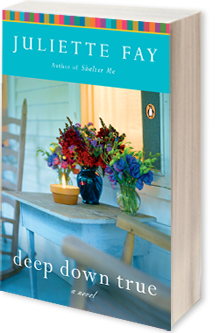 I was lucky enough to score an early copy of Deep Down True at the bookstore in the Providence airport last Friday, and I devoured the book over the course of a long weekend. Good news: I loved it. Bad news: "just one more chapter" took a large chunk out of my beauty sleep. Thanks for the eye socket shadows, Juliette Fay.
I was lucky enough to score an early copy of Deep Down True at the bookstore in the Providence airport last Friday, and I devoured the book over the course of a long weekend. Good news: I loved it. Bad news: "just one more chapter" took a large chunk out of my beauty sleep. Thanks for the eye socket shadows, Juliette Fay.
What struck me first was the fantastic use of imagery. As a writer I struggle to find images that are neither cliché nor distraction; all through this book, fresh images made me smack my lips in the satisfaction of tasting something new that was just exactly right. On page 1, we hear of "the thick humidity of death." On page 3, we learn that for middle school girls, "Their eyes were their weapons now." This steady stream of analogy ties the book together, giving it a literary power that never slows down the page-turning.
The story is told by Dana, a suburban mom whose husband has recently left her for a younger woman. Dealing with her own anger and disappointment is hard enough without also trying to do her best for her two kids, a seven year old boy and a twelve year old girl. Dana is a good mother, but I was grateful she wasn't too good or too perfect. She makes her mistakes too, which is what keeps this story from becoming too sweet.
Best of all, the ending was the perfect combination of nice and not quite finished. We are left with the feeling that while the characters have grown and improved, they will keep leading somewhat imperfect lives. And with just the right unexpected twist, Juliette also manages to sum up once again the theme of adulthood as glorified middle school. Well done!
It usually bothers me to read the acknowledgements before I have read the book, but in this case learning about where the inspiration for the book came from (and where some of the best teenage lines originated) deepened my appreciation of the characters.
If I'd known such great writing could originate in the town where I grew up, I might not have bolted right after high school.
To view the book trailer or buy this book, visit Juliette Fay's website.
December 20, 2010
2010 Holiday Book List
 As a reader, I probably devour 50 books a year, almost exclusively fiction. One of the best parts of my day is crawling into bed with enough time before sleep to delve into an undiscovered story.
As a reader, I probably devour 50 books a year, almost exclusively fiction. One of the best parts of my day is crawling into bed with enough time before sleep to delve into an undiscovered story.
As a writer, I try to create a few new stories a year. Let me tell you, reading is a lot easier. So for all of us readers, it's a good thing there are so many talented authors out there.
As my final 2010 blog present to you, here's my list of recommended reads—to give to yourself, or to someone else.
And no matter what format you consume fiction in these days, I urge you to support your local independent bookstore this holiday. That's the only way to help assure it will still be there for you in 2011, and beyond!
Lipstick in Afghanistan (Roberta Gately)
Roberta is one of my writing friends so I may not be totally subjective on this one. But anyone interested in Afghanistan will learn something from this book, a story about an American nurse whose year in Bamiyan helping the Afghans changes her forever. The best crowd pleaser I read in 2010.
Read my review, Loving Lipstick
The Forgotten Garden (Kate Morton)
Quite simply the best book I read this year. Three generations of women tell an interlocking story about their past, which turns out to affect the present—and future. The book starts off in Morton's home city of Brisbane, but events take all three characters to the coast of Cornwall in England. Enjoy getting lost in this one, as I did.
The Velvet Room (Zilpha Keatley Snyder)
Originally published in 1965, one of my favorite childhood reads is back in print thanks to the Author's Guild Back In Print initiative. The story is simple, about a girl who finds a secret room that she makes her own (and eventually saves from destruction). Like most of my childhood rediscoveries, I was amazed how many details I'd forgotten about plot and scene; what I remembered (and which grabbed me all over again) is the atmosphere of safety and comfort the author creates by encircling a window seat in velvet curtains.
Diamond Ruby (Joe Wallace)
Although I've never met Joe Wallace, I've enjoyed getting to know him via word spurts of 140 characters (Twitter's @Joe_Wallace). Diamond Ruby will be opened under two Christmas trees in my family this year, and hopefully both my nephew and niece will enjoy this story of a young girl growing up in 1930's Brooklyn who strikes out Babe Ruth. Joe says that many male friends have complained this wasn't realistic, but Diamond Ruby is based on a true character (Jackie Mitchell) who really did strike out Babe Ruth—shortly before the commissioner banned women from playing baseball "for their health." Like all authors, Joe has mixed history with imagination to create a wonderful tale.
And in a seasonal toast to e-books, here are two available only on Smashwords:
Sentence of Marriage (Shayne Parkinson)
The first of a series about a young girl growing up in rural Australia in the late 1800's. I read this one and couldn't wait to read the next three books.
The Wrecking Crew (Mark Chisnell)
A gripping ocean-based thriller by a well-known British sailing writer. Great airplane read!
Other books I reviewed in 2010
The Murderer's Daughters (Randy Susan Meyers)
An intensely dark but still hopeful novel about two sisters whose father murders their mother. This will be out in paperback in early 2011, and hopefully that edition is just as beautiful as the hardcover. Read my review
The Sea and the Silence (Peter Cunningham)
A page-turning novel (with a beautiful cover) about the life of an Irish woman who comes of age during the 1940's. Read my review, Savouring The Sea and the Silence
The Swimming Pool (Holly LeCraw)
My "much more than just a beach read" of the year. A surprisingly intense look into a family who summers on the Cape.
Read my review, Diving into The Swimming Pool
Sea Escape (Lynne Griffin)
A fictional escape into the lives of a family trying to cope with the past through letters and memories. Read my review, Escaping to the Sea
Wishing you happy gift giving in 2010, and more time to read in 2011!
December 10, 2010
Loving Lipstick
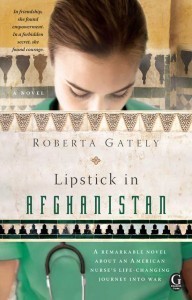 Way back in 2007, I took my novel-that-should've-stayed-in-a-drawer to New York City for the Pitch and Shop Conference. My goal (like all the other students) was to wow an agent, sign a contract, and publish my book. Little did I know that the real victory would be meeting Roberta Gately.
Way back in 2007, I took my novel-that-should've-stayed-in-a-drawer to New York City for the Pitch and Shop Conference. My goal (like all the other students) was to wow an agent, sign a contract, and publish my book. Little did I know that the real victory would be meeting Roberta Gately.
Roberta was pitching "Lipstick in Afghanistan," a novel based on her own experiences as a war-zone nurse. I don't remember anything from my own presentation, but I do remember the last line of hers: "One of them will not survive." I also remember telling her that she'd better hurry up and publish while Afghanistan was still in the news—quite optimistic, in hindsight.
I was quickly drawn to this small determined woman, and not just because of her writing. Her cut-to-the-chase Boston accent was tempered by a gracious tolerance for our fellow conference attendees. "I love his ideas," she'd say, referring to a man whose writing was indecipherable to me. Another guy who constantly interrupted everyone (even the instructor) received the following benediction: "He's got such energy." She could always find something positive to say. And I had to agree with all her assessments, even if my own weren't as saintly.
After the conference we kept in touch, sharing manuscripts and ideas. I have to admit that when Roberta first sent me her work I could barely follow the story. She had packed all her enthusiasm for Afghan history, culture, and people onto the page, bogging down the narrative.
"Try taking out some of the background," I suggested, trying to be gentle. "As the author you need to know about Elsa's childhood, but as a reader I just want to know what happens to her next."
The second draft was much better. I gave her some more feedback, and other than a few chatty emails I heard nothing further—until a year later, when I got an unexpected call: "Carol, I sold my book!" I was almost as excited as she was to see her hard work and perseverance rewarded.
Roberta became a published author because she kept at it, editing and re-editing to chisel out the story—and then editing again once Simon and Schuster took charge. I'm so glad, because she has polished this tale of love and war into a real gem. The finished book has just the right amount of detail to keep the story moving forward, and as an author I understand how much work that apparent simplicity required.
As an editor, I can of course find something to criticize. Toward the end of the book, I found the point of view transitions between Elsa and Parween, her Afghan friend, a bit sudden. But by then I was so caught up in the characters' lives that I didn't care. (I even realized at one point that I'd forgotten who the author was.)
The teaser prologue made the climactic scene even more dramatic—and it's true, "One of them will not survive." Through nurse Elsa's eyes, I've now tasted the Afghan dust, seen the fear in burqa-clad women's eyes, heard the scurrying children call out to the woman from "Amrika." I now know a little of this landlocked country on the other side of the globe, which makes the news stories all the more real.
It shouldn't surprise me that Roberta—who does aid work around the globe—has written a story that will help us understand how much we have in common with the people of Afghanistan. I've watched her novel grow and improve, and now I'll watch it earn the respect and love of readers everywhere. What a treat to be constantly surprised by my first true writing friend—and to finally hold her finished book in my hands.
I can't wait to see the movie.


